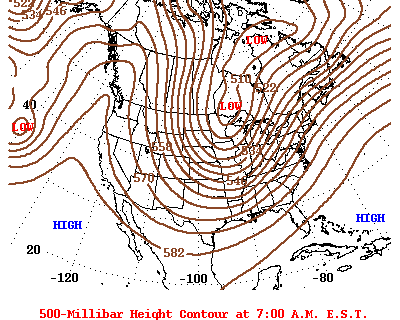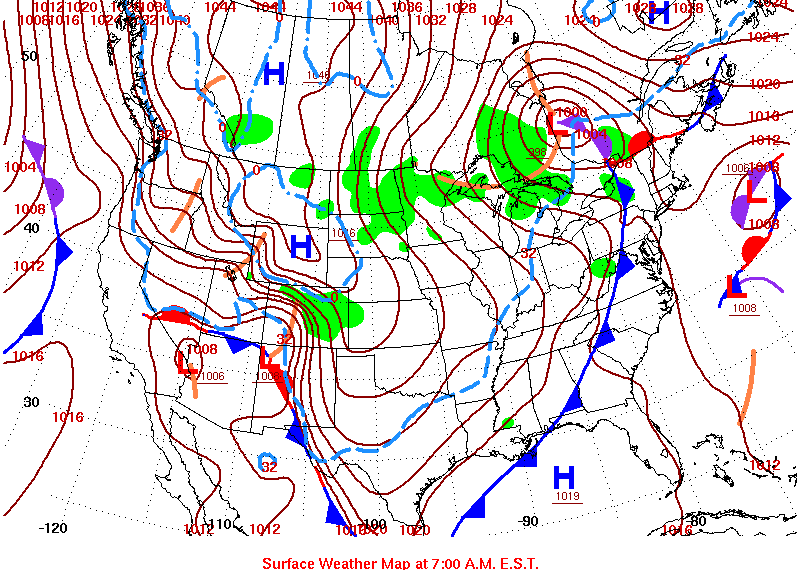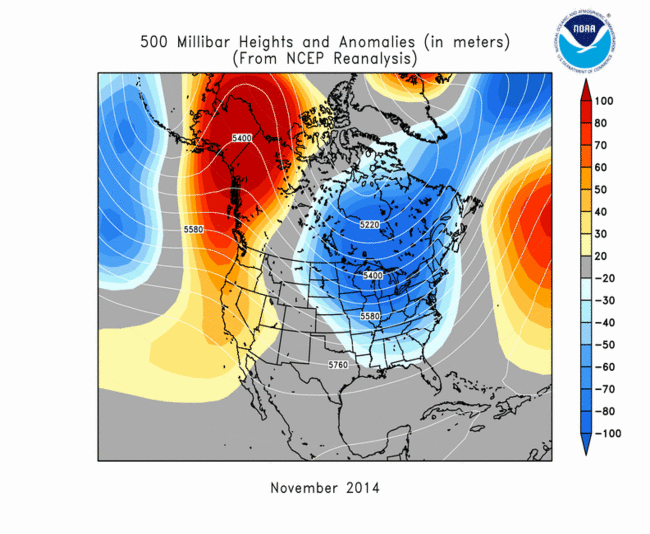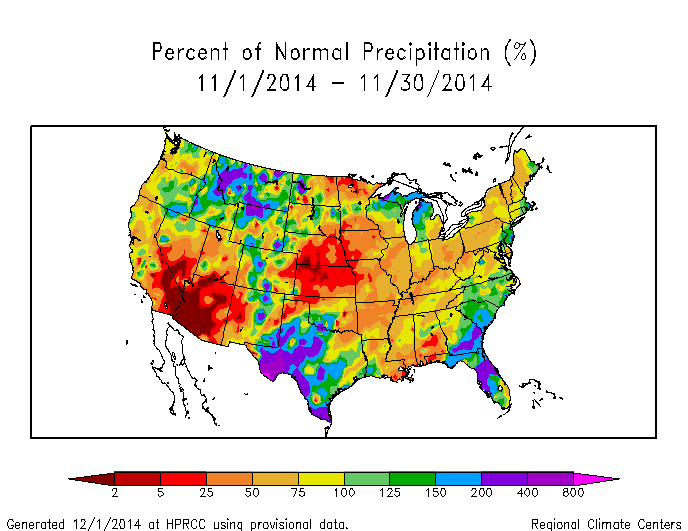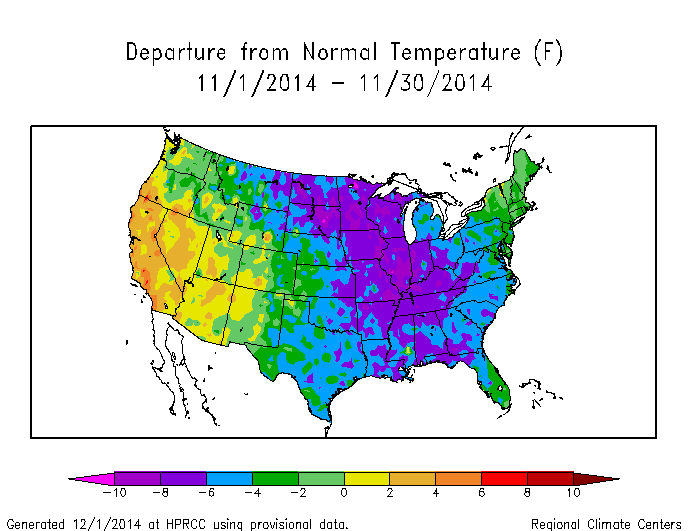Note: This Synoptic Discussion describes recent weather events and climate anomalies in relation to the phenomena that cause the weather. These phenomena include the jet stream, fronts and low pressure systems that bring precipitation, high pressure systems that bring dry weather, and the mechanisms which control these features — such as El Niño, La Niña, and other oceanic and atmospheric drivers (PNA, NAO, AO, and others). The report may contain more technical language than other components of the State of the Climate series.
Summary
November 2014 was characterized by an active jet stream with a strong meridional flow over the contiguous United States (CONUS). A long-wave trough brought below-normal temperatures east of the Rockies for much of the month. Weather systems moving in the circulation generated areas of precipitation in parts of the country, which shrank the national drought footprint slightly, and a widespread snow cover at mid-month. But drier-than-normal weather accompanied a western ridge and a dominant northwesterly flow east of the Rockies, resulting in the 46th driest November in the 1895-2014 record. The upper-level circulation pattern, and temperature and precipitation patterns, suggest that the weather and climate of November 2014 were influenced very strongly by conditions in the North Pacific, with the remnants of tropical cyclone Nuri playing a crucial role. See below for details.
Synoptic Discussion
|
In the Northern Hemisphere, November marks the end of climatological fall (autumn), which is the time of year when solar heating decreases as the sun angle decreases and an expanding circumpolar vortex forces the jet stream to migrate southward. In November 2014, the remnants of super typhoon Nuri moved into the North Pacific, generating record low pressure as an extra-tropical cyclone in the Bering Strait. This created a strong meridional circulation downstream, causing the jet stream to surge far south across the contiguous U.S. (CONUS) and funneling cold arctic air masses east of the Rockies. Short-wave troughs frequently moved through the strong meridional flow, bringing areas of precipitation and a rapidly expanding snow cover. The jet stream trough provided the below-freezing air, and the Gulf of Mexico provided the moisture, so that, by November 17th, snow covered about half of the CONUS, with the November North American and contiguous U.S. snow cover extent setting new highs in the 1966-2014 satellite record. Upper-level ridging over the western U.S. brought above-normal temperatures and below-normal precipitation to the Southwest, while the predominant northwesterly flow associated with the upper-level trough inhibited precipitation across the central CONUS. |
|
The upper-level trough established itself by mid-month and persisted for a couple weeks, sending several cold fronts at the surface across the central and eastern CONUS. These reinforcing surges of cold air (weeks 1, 2, 3, 4) gradually sent the monthly temperature anomaly plummeting (November 9, 16, 23), with daily temperature records mounting. By the end of the month, about 9,197 record cold daily high (4,955) and low (4,242) temperature records had been set — 3.5 times as many (2,657) record warm daily high (1,337) and low (1,320) temperature records. This was reflected in the national monthly average temperature which ranked November 2014 as the 16th coldest November in the 1895-2014 record. It was also reflected in the 14th highest REDTI (Residential Energy Demand Temperature Index) for November, indicating that the widespread below-normal temperatures increased the energy needed to heat homes. The remnants of Nuri forced a long-wave ridge in the upper-level circulation over western North America, Alaska, and the eastern North Pacific. A southwesterly flow, associated with the ridge, brought warmer-than-normal air to Alaska, while the ridge warmed the western CONUS. The ridge inhibited precipitation, giving Alaska a drier-than-normal month. The dry arctic air masses funneled by the northwesterly flow associated with the trough east of the Rockies resulted in fewer days with precipitation and a drier-than-normal month in the interior CONUS. This circulation pattern also inhibited the development of severe weather, with only 27 tornadoes developing compared to the average count of 58 tornadoes for November. Storms, which formed along the southern edge of the arctic air masses, tapped Gulf of Mexico moisture to bring above-normal precipitation to the drought areas of the Southern Plains and Southeast, improving drought conditions in those regions and shrinking the national drought footprint slightly compared to the end of October. The contrast in temperatures across the cold fronts, the presence of Gulf moisture, and dynamic localized circulation associated with some of these storms were responsible for the development of the tornadoes, all of which occurred in the Southeast. |
|
When integrated across the month, the atmospheric circulation indicated a pattern of above-normal 500-mb heights (stronger-than-normal long-wave ridge) over western North America, with below-normal 500-mb heights (stronger-than-normal long-wave trough) over the eastern half of North America and also the North Pacific south of the Bering Strait. The anomaly couplet over the North Pacific strongly reflects the influence of the extra-tropical remnants of Nuri — Nuri's deep low pressure lowered the 500-mb heights near and south of the Bering Strait, while the strong southerly circulation east of the center of Nuri raised the heights over Alaska and the west coast of North America. |
|
Above-normal precipitation fell across parts of the Northern Rockies, Southern Plains, and Southeast. Precipitation was below normal across much of the country, including the West Coast, Southwest, Central Plains, Mississippi and Ohio Valleys, and interior Northeast. November was drier than normal over most of Alaska and the Hawaiian Islands. |
|
November temperatures were colder than normal across most of the CONUS and above-normal over the Southwest and Alaska. |
Global Linkages: The upper-level ridge/trough circulation pattern over North America propagated downstream, with anomalous ridge/trough couplets occurring over the Atlantic Ocean and Eurasia. Above-normal 500-mb heights, associated with ridging in the upper atmosphere, were reflected by above-normal temperatures at the surface over Europe and eastern Asia and below-normal precipitation over eastern Europe to western Russia. Below-normal 500-mb heights, associated with troughs in the upper atmosphere, were reflected by near- to below-normal temperatures at the surface over eastern North America and northern Siberia, and above-normal snow cover across much of North America.
Atmospheric Drivers
Subtropical highs, and fronts and low pressure systems moving in the mid-latitude storm track flow, are influenced by the broadscale atmospheric circulation. The circulation of the atmosphere can be analyzed and categorized into specific patterns. The tropics, especially the equatorial Pacific Ocean, provides abundant heat energy which largely drives the world's atmospheric and oceanic circulation. The following describes several of these modes or patterns of the atmospheric circulation, their drivers, the temperature and precipitation patterns (or teleconnections) associated with them, and their index values this month:
-
El Niño Southern Oscillation (ENSO)
- Description: Oceanic and atmospheric conditions in the tropical Pacific Ocean can influence weather across the globe. ENSO is characterized by two extreme modes: El Niño (warmer-than-normal sea surface temperature [SST] anomalies in the tropical Pacific) and La Niña (cooler-than-normal SST anomalies), with the absence of either of these modes termed "ENSO-neutral" conditions.
- Status: Ocean surface temperatures and several other features across the tropical Pacific were characteristic of borderline El Niño conditions, but collectively, the combined atmosphere and oceanic state remained ENSO-neutral during November.
- Teleconnections (influence on weather): To the extent teleconnections are known, while in a neutral state, ENSO normally is not a player in the month's weather. Historical data has been analyzed by NOAA to show typical temperature and precipitation patterns associated with El Niño and La Niña ENSO episodes. Teleconnections are not available for ENSO-neutral conditions at that NOAA web site. If an El Niño were happening during November, the typical precipitation pattern would consist of wetter-than-normal conditions in the Southwest, Southern Plains, and Florida, and drier-than-normal conditions across the northern tier states and Ohio Valley, and in parts of the Deep South. The typical temperature pattern would consist of below-normal temperatures across most of the southern tier states and above-normal temperatures in the Northwest and Northern Plains.
- Comparison to Observed: The November 2014 temperature anomaly pattern shows little resemblance to that expected with an El Niño, and the precipitation anomaly pattern has similarities in some areas (Southern Plains, Florida, Ohio Valley, Northeast) but not in the West.
-
Madden-Julian Oscillation (MJO)
- Description: The MJO is a tropical disturbance or "wave" that propagates eastward around the global tropics with a cycle on the order of 30-60 days. It is characterized by regions of enhanced and suppressed tropical rainfall. One of its indices is a phase diagram which illustrates the phase (1-8) and amplitude of the MJO on a daily basis. The MJO is categorized into eight "phases" depending on the pattern of the location and intensity of the regions of enhanced and suppressed tropical rainfall. The MJO can enter periods of little or no activity, when it becomes neutral or incoherent and has little influence on the weather. Overall, the MJO tends to be most active during ENSO-neutral years, and is often absent during moderate-to-strong El Niño and La Niña episodes.
- Status: The MJO started the month incoherent, then transitioned into phases 1, 2, and 3, ending the month in phase 4. The MJO indices appeared to be influenced by other modes of coherent subseasonal tropical variability, including Kelvin and Rossby waves.
- Teleconnections (influence on weather): The MJO's temperature and precipitation teleconnections to U.S. weather depend on time of year and MJO phase. To the extent teleconnections are known, the October-December teleconnections for temperature are shown here and for precipitation are shown here.
- Comparison to Observed: The MJO is transitory and can change phases (modes) within a month, so it is more closely related to weekly weather patterns than monthly. The November 2014 weekly and monthly precipitation and temperature anomaly patterns show little resemblance to the teleconnections for MJO phases 1 through 4.
- The Pacific/North American (PNA) pattern
- Description: The PNA teleconnection pattern is associated with strong fluctuations in the strength and location of the East Asian jet stream. PNA-related blocking of the jet stream flow in the Pacific can affect weather downstream over North America, especially the West and especially in the winter half of the year.
- Status: The daily PNA index was positive for most of the month, then turned negative at the end of the month, averaging positive for the month as a whole. The 3-month-averaged index has been positive in recent months after a long run of mostly negative for the last two years.
- Teleconnections (influence on weather): To the extent teleconnections are known, for a positive PNA, the temperature teleconnection map for this time of year (October on the teleconnection maps) shows warmer-than-normal temperatures in Alaska, western Canada, and the west coast of the U.S., and cooler-than-normal temperatures for the Southern Plains and southeastern CONUS. The precipitation teleconnection map shows drier-than-normal weather in the Great Lakes to Ohio Valley (although the teleconnections for precipitation are weak). The upper-level circulation anomaly teleconnections show above-normal heights over western Canada and the western CONUS, and below-normal heights over the southeastern and eastern CONUS.
- Comparison to Observed: The November 2014 temperature and precipitation anomaly patterns show little agreement with a positive PNA. The November 2014 upper-level circulation anomaly pattern shows some agreement, but the positions are shifted westward and their strength is stronger.
- The Arctic Oscillation (AO) pattern
- Description: The AO teleconnection pattern relates upper-level circulation over the Arctic to circulation features over the Northern Hemisphere mid-latitudes and is most active during the cold season.
- Status: The daily AO index oscillated between positive and negative, averaging negative for the month. The 3-month-averaged index was negative in November reflecting the dominance of the negative monthly values for the last several months.
- Teleconnections (influence on weather): To the extent teleconnections are known, a negative AO this time of year (October-December) is typically associated with dry conditions in the Southern Plains to Southeast, wet conditions in New England and Northern California, below-normal temperatures in a triangle from the Northern Plains to the East Coast and near normal temperatures elsewhere in the CONUS, and upper-level circulation anomalies which are below normal from the Northern Plains to the Mid-Atlantic and Northeast coasts and across much of the North Pacific, and above normal over the Canadian Archipelago and Arctic Sea.
- Comparison to Observed: The November 2014 monthly temperature anomaly pattern is colder than normal where the AO teleconnections are cold. The upper-level circulation anomaly pattern has some agreement in the eastern CONUS, but the overall hemispheric pattern does not match. The precipitation anomaly pattern does not match.
- The North Atlantic Oscillation (NAO) pattern
- Description: The NAO teleconnection pattern relates upper-level circulation over the North Atlantic Ocean to circulation features over the Northern Hemisphere mid-latitudes.
- Status: The daily NAO index was neutral but trending positive, averaging positive for the month. The 3-month-averaged index was turning positive after many months in negative territory.
- Teleconnections (influence on weather): To the extent teleconnections are known, a positive NAO during this time of year (October on the teleconnection maps) is associated with wetter-than-normal conditions in the Midwest and southwest Alaska (although the teleconnections are weak for precipitation), positive upper-level circulation anomalies across the North Atlantic and CONUS east of the Rockies, and negative upper-level circulation anomalies over the Canadian Archipelago. The temperature teleconnections show no correlation across the CONUS but slight positive correlation across southwest Alaska.
- Comparison to Observed: The November 2014 monthly precipitation, temperature, and upper-level circulation anomaly patterns show no agreement with those expected with a positive NAO.
- The West Pacific (WP) pattern
- Description: The WP teleconnection pattern is a primary mode of low-frequency variability over the North Pacific and reflects zonal and meridional variations in the location and intensity of the (East Asian) jet stream in the western Pacific.
- Status: The monthly WP index was near zero for the month, but the three-month average WP index negative for the last 12 to 18 months.
- Teleconnections (influence on weather): There are no teleconnection maps for a neutral WP. To the extent teleconnections are known, a negative WP during this time of year (October on the maps) is typically associated with below-normal temperatures in the Central Plains to Upper Midwest, wet conditions in the Deep South, Upper Midwest, and Northwest, and below-normal circulation anomalies over the Northern to Central Plains, Upper Midwest, and central to western Canada.
- Comparison to Observed: The November 2014 monthly temperature, precipitation, and upper-level circulation anomaly patterns show some similarity to those expected with a negative WP in some areas where teleconnections exist, but the overall patterns do not match.
- The East Pacific-North Pacific (EP-NP) pattern
- Description: The EP-NP teleconnection pattern relates SST and upper-level circulation patterns (geopotential height anomalies) over the eastern and northern Pacific to temperature, precipitation, and circulation anomalies downstream over North America. Its influence during the winter is not as strong as during the other three seasons.
- Status: The magnitude of the warmth of the SSTs in the northeastern North Pacific increased slightly this month, with the November SST pattern still showing above-normal SSTs along the North American coast and near-normal SSTs to the west. The monthly EP-NP index was strongly positive during November, pulling the 3-month running mean well into positive territory.
- Teleconnections (influence on weather): To the extent teleconnections are known, a positive EP-NP index during this time of year (October on the maps) is typically associated with colder-than-normal temperatures east of the Rockies, warmer-than-normal temperatures across the extreme West Coast and in Alaska, drier-than-normal conditions in the Northwest and wetter than normal in southern Alaska (although the precipitation teleconnections are very weak), above-normal upper-level circulation anomalies (stronger upper-level ridge) over Alaska and western Canada and into the Pacific Northwest, and below-normal upper-level circulation anomalies (stronger upper-level trough) east of the Rockies.
- Comparison to Observed: The November 2014 temperature and upper-level circulation anomaly patterns agree very well with the patterns expected with a positive EP-NP, while the precipitation anomaly pattern shows some agreement where teleconnections exist.
Examination of these circulation indices and their teleconnection patterns, and comparison to observed November 2014 temperature, precipitation, and circulation patterns, suggest that the weather over the CONUS in November was strongly influenced by activities in the North Pacific Ocean, although there were hints that the jet stream and ocean-atmosphere interactions over the Arctic (AO) and equatorial Pacific exerted some limited influence. The remnant cyclone that was Nuri had a major influence on the downstream circulation over North America when it moved into the North Pacific, an interaction that was consistent with a positive EP-NP. This Pacific influence appeared to overwhelm any influence that may have been exerted by the PNA, NAO, and MJO, although the AO could have been influential when it was in phase with the EP-NP (i.e., negative AO). The WP was neutral during the month. ENSO was still classified as neutral, but equatorial Pacific oceanic conditions were slowly evolving toward an El Niño state and there was some hint that precipitation anomaly patterns east of the Rockies could have been influenced by the developing El Niño.
This month illustrates how an extremely powerful weather system (the extratropical cyclone that was the remnants of Typhoon Nuri) can impact the monthly weather and climate anomaly patterns by reinforcing one atmospheric driver (or mode of atmospheric variability) (as reflected by the EP-NP North Pacific teleconnection index).
 NOAA's National Centers for Environmental Information
NOAA's National Centers for Environmental Information
